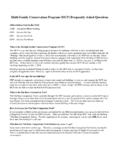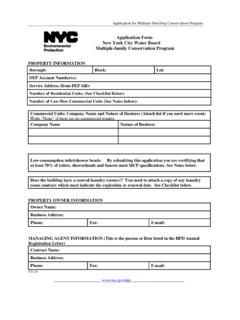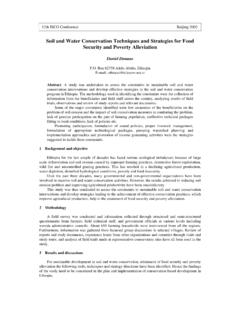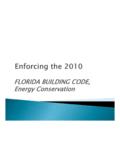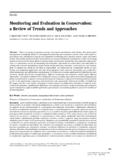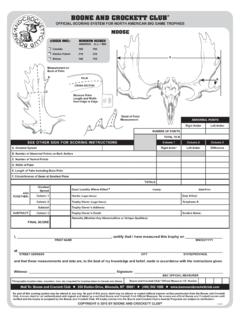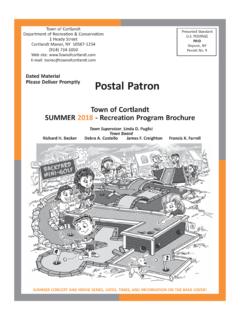Transcription of Final Report Colorado River System Conservation …
1 Final Report Colorado River System Conservation PILOT PROGRAM IN THE UPPER Colorado River BASIN Prepared for: The Upper Colorado River Commission Prepared by: UCRC Staff & Wilson Water Group 165 S. Union Blvd. Suite 520 Lakewood, CO 80228 February 2018 Table of Contents Executive Summary I. Executive Summary .. 3 II. Background .. 5 III. System Conservation Pilot Program Approach .. 6 A. Evaluation Criteria and Project Selection .. 6 B. Project Verification .. 6 IV. System Conservation Pilot Program Results .. 7 A. Summary of Selected Projects .. 7 B. Summary of the Contracted Conserved Water and Associated Cost.
2 12 C. Summary of the SCPP Conserved Consumptive Use Analyses .. 16 V. System Conservation Pilot Program Project Monitoring .. 16 VI. Lessons Learned .. 17 A. Program Administration and Project Implementation .. 17 B. Operational Lessons .. 19 C. Project Costs, Benefits, and Risks .. 26 D. Legal Constraints .. 27 E. Community Outreach and Education .. 28 Appendix A: System Conservation Pilot Program Consumptive Use Analysis (2015) .. 30 Appendix B: System Conservation Pilot Program Consumptive Use Analysis (2016) .. 33 Page 2 I. Executive Summary The following Report is intended to summarize the outcomes and lessons learned from the three-year Colorado River System Conservation Pilot Program (SCPP) as implemented in the Upper Colorado River Basin (Upper Basin) beginning in The Upper Basin SCPP is part of a larger, basin-wide program that was funded by four Colorado River municipal water users--the Central Arizona Water Conservation District, the Southern Nevada Water Authority, the Metropolitan Water District of Southern California (MWD)
3 , and Denver Water-- partnering with the Bureau of Reclamation (collectively, the Funding Agencies). In 2017, the Walton Family Foundation also contributed to the Upper Basin SCPP through Denver Water. The overall goals of the SCPP were to, among other things, help explore, learn from and determine whether a voluntary, temporary and compensated reduction in consumptive use in the Upper Basin is a feasible method to partially mitigate the decline of or to raise water levels in Lake Powell and thereby serve as a useful tool for the drought contingency planning processes in the Upper Basin. Thus, the primary objective of the pilot program was not to test whether conserved water actually reaches Lake Powell, but rather to assess the feasibility of System Conservation as a future means of increasing storage at the reservoir.
4 From 2015-2017, the Upper Basin SCPP funded 45 projects, for a consumptive use reduction of approximately 22,116 acre-feet at a total cost of $4,555,747. There was significant interest and program participation in the Upper Basin. With assistance from the four Upper Colorado River Division States ( Colorado , Utah, Wyoming, and New Mexico) as well as facilitation by key non-governmental organizations (NGOs), the Upper Basin SCPP received 93 applications from 2015 through 2017. Information about the SCPP was collected that will inform the future of the program, or a similar demand management effort, including recommendations for potential improvements.
5 In addition to demonstrating significant Upper Basin water user interest, t he SCPP was also successful in demonstrating and accomplishing the administrative requirements for such a program. These included solicitation of proposals from water users; review, ranking and selection of projects; contracting; field verification of consumptive use savings; payment management and processing; and, management and coordination of activities among multiple funding agencies. The SCPP successfully demonstrated water user interest, administrative capabilities and requirements, as well as greatly advanced learning all of which have contributed to a better understanding of whether and how voluntary reductions in consumptive use in the Upper Basin may help protect critical reservoir levels during drought Among the broader-based observations involved in implementing this program, the following have emerged: 1.
6 The Upper Colorado River Commission (UCRC) gained an understanding of the requirements to administer, contract, and pay for Conservation activities; 2. It is valuable to have key stakeholders and NGOs participate in program outreach; 1 In August 2017, the Upper Colorado River Commission agreed to extend the SCPP through 2018 to further study the feasibility of the Program in the Upper Basin. A summary of the fourth year of SCPP in the Upper Basin will be included as an appendix to this Report upon conclusion of the 2018 projects. Page 3 3.
7 There can be multiple benefits of Conservation , including fuller target reservoirs, in-channel benefits, and benefits to agricultural production through soil resting ; 4. Sufficient resources for program administration must be provided; 5. Additional groups may be interested in providing potential funding including public water providers, NGOs, and the federal government; 6. Improved methods of estimating Conservation , such as remote sensing, may be useful; 7. The desire to generate publicity about program participation varies among selected applicants; 8. Involvement by trusted local and state representatives is critical in attracting agricultural water user participation; 9.
8 The availability of historical crop and water use data and information on a proposed site is beneficial to understanding potential Conservation benefits; 10. The SCPP served as a valuable tool for educating local water managers, administrators, and water users about the Colorado River System ; and 11. Conservation may be a tool to improve reservoir conditions provided legal, technical and policy issues can be resolved. The underlying goal of the SCPP was to learn about the logistics and challenges associated with implementing this type of pr ogram. The operation of the pilot program showed: 1) there is participation interest within the Upper Basin; 2) it is possible to contract and verify Conservation measures; and, 3) competitive pricing can support Conservation efforts.
9 Because of the learning successes of the pilot program between 2015 and 2017, the SCPP has been extended into 2018. See footnote 1. Additionally, the information garnered in the first three years of the pilot program has helped clarify remaining questions that need to be answered to support a long-term management program. The following questions should be addressed in conjunction with the lessons learned detailed in this Report : 1. What is the role and objective of a more permanent System Conservation Program? For example, is it an intermittent tool used only when Lake Powell hits critical elevations for large- scale demand management; or, is it vehicle to implement more local water banking options to benefit Upper Basin water users?
10 2. What can be done to ensure that conserved water gets to Lake Powell? 3. What can be done to improve the ability to measure conserved water volumes? 4. Can projects generate the amount of conserved water that modeling conducted by the Upper Basin suggests may be required to have measurable impacts; and, 5. What are the direct and indirect benefits and impacts to local areas from a significant level of Conservation ? 6. What would be the source of financial support for measurable demand management volumes, recognizing current unit costs? For example, is it feasible to secure roughly $40 million to conserve approximately 200,000 acre-feet based on the 2017 SCPP unit costs?
